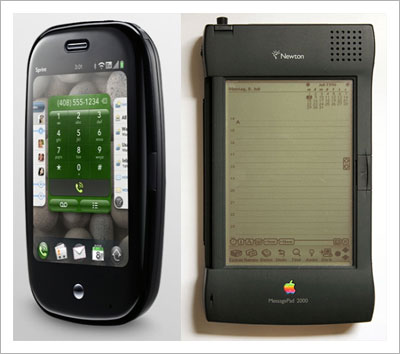How Palm Became the Next Newton

The history of tech is so ironic: Once upon a time in the early 90s Apple gave birth to the first real PDA — the Newton. I was at the first MacWorld in Boston when an army of eager developers got their hands on this gizmo, you could feel the magic in the air. In retrospect most people look at all of the flaws of the Newton (like a hand writing recognition) but people forget what a breakthrough it was at the time.
The reason why most folks forgot the Newton was because of the Palm which went on to own the PDA category for the rest of the 90s. The first generation of Palm came out in 1996 after John Sculley left Apple — but before Steve Jobs would return. The timing was great for Palm — and to their credit they got all of the details right. For starters the interface design was A+ — they spent hours trying to figure out how to save the user time, and they also made it a point not to overreach by not doing handwriting recognition. The usability went one step further: The Palm did a great job of working well on the desktop and with early versions of Windows. Lastly they also did a great job of getting third party developers to write a huge number of applications. When you added all of this up with a low price point you had a killer platform.
The ultimate compliment came to Palm when in 1998 Steve Jobs after returning to Apple decided to kill off the Newton — much to the horror of many an Apple fanboy like myself. Although I couldn’t complain too much at that point as I had made the switch myself, although being a Mac user I always felt like a second class citizen. And when the time time came for my first generation smartphone my logical choice was the Treo. In fact I couldn’t understand why anyone would have wanted to own a first generation iPod when the Treo had a cell phone AND an mp3 player. Why would you want two gizmos taking up your pocket space?
But soon my frustration grew with Palm as hey started to die. The exact point that this occurred was when they introduced a version with Windows Mobile. Now this isn’t to slag Windows Mobile, but the entire point of the platform was the ease-of-use of the operating system. Also the Treo had very bad cell phone reception — and on top of this the phone functionality was sort of hacked onto to the existing interface: The result for me in the long run was a very frustrating user experience.
And then Apple got back into my life: I avoided the first generation of iPods, but a good friend gave me a Nano as a Christmas gift one year. I hadn’t realized it at the time, but at this point Apple had started to do to Palm what Palm did to the Newton. In this case Apple’s trojan horse was iTunes which I ran on Windows (even though I had a Mac). So when the iPhone came out it was a no-brainer: My Treo was toast!
But now we jump to CES this year where Palm has rolled out there their latest and greatest: And sadly the Palm Pre looks like a second rate iPhone. Now don’t get me wrong: There’s a HUGE market for iPhone clones. In fact my bet is within a few years what we will think of as a cell phone will be an iPhone clone (much like what Windows is to the Mac). But this is a huge problem for Palm because every other cell phone manufacturer will be doing the same thing.
Anything that made Palm a unique buying proposition is now gone — and in retrospect the irony is that Apple has managed to turn Palm into what the Newton was in 1998: An extinct platform. What Palm might have done was the somehow reinvent the category which is what put them on the map, but looking at the Pre you get the feeling that you are looking at the beginning of the end.














